7. communication and learning disorders
1/27
There's no tags or description
Looks like no tags are added yet.
Name | Mastery | Learn | Test | Matching | Spaced |
|---|
No study sessions yet.
28 Terms
4 diagnostic categories of communication disorders
speech sound disorder
language disorder
childhood-onset fluency disorder (stuttering)
social (pragmatic) communication disorder

speech sound disorder + common symptom
when the developmental language problem involves articulation or sound production rather than word knowledge
phonological awareness vs. phonological processing
trouble controlling their rate of speech, or lag behind playmates in learning to articulate certain sounds
when is assessment and intervention warranted for speech sound disorder (2 options)?
issues persist beyond typical dev range (age 4)
issues interfere w academic and social activities by age 7
language disorder + symptoms
communication disorder characterized by difficulties in the comprehension or production of spoken or written language
reduced vocab
limited sentence structure (ability to put words and word endings tgt to form sentences based on the rules of grammar and morphology
impairment in discourse
social communication disorder + symptoms + typical age of diagnosis
persistent difficulties in pragmatics involving both expressive and receptive skills
deficits in using communication for social purposes
difficulties in changing their communication to match the situation or the listener
problems following the rules of language
difficulties understanding what someone is not explicitly saying
4-5 yo
pragmatics
culturally specific practices and skills related to social uses of language, conversational norms, and the use of nonverbal communication, such as eye contact and gestures
foundational skills impaired in speech sound disorder, language disorder, and social (pragmatic) communication disorder
speech sound disorder: articulation and phonological processing
language disorder: comprehension and use of language
social (pragmatic) communication disorder: use of language in social contexts
genetic and brain-related causes of language disorder
genetics
positive family history of some type of learning disability
temporal processing deficits
brain
circular feedback loop in left temporal lobe
problems in connections btwn brain areas
less brain activity in left temporal region
does parental speech and language stimulation cause language disorder?
no. but it does affect the pace and range of language development
phonemes
basic sounds that make up language
perceptual maps
formed to represent similarities among sounds and help the infant learn to discriminate among different phonemes
phonology
ability to learn and store phonemes as well as the rules for combining the sounds into meaningful units or words
phonological awareness
recognizing the relationship btwn sounds and letters, detecting rhyme and alliteration, and awareness that sounds can be manipulated within syllables in words
treatment based on 3 principles
promote the child’s language competencies
adjust the env in ways that accommodate the child’s needs
therapy to equip them w knowledge and skills to reduce behavioral and emotional symptoms
specific learning disorder
specific problems in learning and using academic skills as defined by the DSM-IV-TR
learning disability
learning problems that occur in the absence of other obvious conditions
not visible and often undetected in young children
unexpected discrepancy
ppl w learning disabilities have intact intellectual processes in most areas but are relatively weaker in others, so they have an unexpected discrepancy btwn measured ability and actual performance
relationship btwn learning disorder and learning disabilities
all learning disorders are learning disabilities bc it impacts academic performance and may require special education services.
BUT not all learning disabilities are learning disorders. even a student without a formal DSM diagnosis can be classified as having a learning disability
5 characteristics of SLD
main diagnostic feature of SLD is difficulties learning keystone academic skills: reading, writing, spelling, or math
learning difficulties: specific, not due to intellectual developmental disorder, and not due to global developmental delay
***achievement test scores are at least 1.5 SDs below average for their age and sex
performance difficulties interfere w academic achievement or daily living
must persist for more than six months despite efforts to improve
core deficit of SLD in reading
problems in decoding -- breaking a word into parts rapidly enough to read the whole word -- coupled w difficulty reading single small words
nonverbal learning disability (NLD)
associated w deficits related to right-hemisphere brain functioning, which are characteristic of children who perform considerably worse at math than reading
“twice exceptional” children
children and adolescents who qualify as both gifted and learning disabled
SLD w impairment in reading most common underlying feature + 4 errors
inability to distinguish or separate sounds in spoken words
reversals (b/d, p/q)
transpositions (was/saw, scared/sacred)
inversions (m/w, u/n)
omissions (says place for palace, section for selection)
response to intervention models (RTI)
consists of tiered instruction
children who have reading difficulties are provided w small-group, intensive instruction
those who need additional intervention may receive one-on-one special education
seeks to provide each child w the appropriate lvl of instruction required for their indiv needs
most educators today favor direct instruction for children w learning disorders. what is that?
a straightforward approach to teaching based on the premise that to improve a skill, the instructional activities must approximate those of the skill being taught
faultless instruction
behavioral method that places a strong emphasis on the behavior of the teacher in terms of explicit correction, reinforcement, and practice opportunities
basically, each concept should be so clearly presented that only one interpretation is possible
what do cognitive-behavioral interventions emphasize?
self-control by using strategies such as self-monitoring, self-assessment, self-recording, self-management of reinforcement, and so on
children taught to ask themselves several questions as they progress, to make themselves more aware of the material
computer-assisted learning
provide more academic engagement and achievement than traditional pencil-and-paper methods